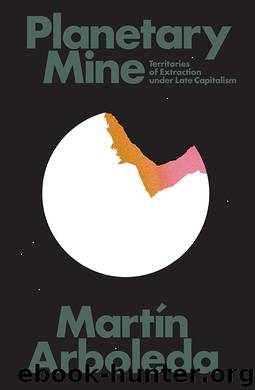Planetary Mine by Martin Arboleda

Author:Martin Arboleda
Language: eng
Format: epub
Publisher: Verso Books
Finance and the Real Subsumption of Nature to Capital
The shift from formal to real subsumption, as noted earlier, has historically enabled capital to transcend biological, geological, and even temporal limits to capital accumulation. As the constitutive outside of capital can no longer be cast in purely territorial terms (due to the completion of the world market), the intensification of the labor process via technological change enables the continuous production of this outside, even within the physical boundaries of the capitalist system. Boyd, Prudham, and Schurman were the first authors to apply Marx’s distinction of formal/real subsumption to (external) nature systematically.29 For these authors, the real subsumption of nature refers to systematic increases or intensification of biological productivity with the purpose of accelerating turnover times of capital. Nature, they argue, is not merely appropriated but rather (re)made to work harder, faster, and better. With the real subsumption of nature, capital circulates through nature as opposed to around it and biological systems are made to act as actual forces of production.30 Despite its relevant contributions, this account presents two major shortcomings: it only considers the real subsumption of nature applicable to biologically based systems and industries, and it reproduces an externalist conception of nature that excludes the subordination of the human species (also part of nature) to capital.
The former of the above considerations leads Neil Smith to contend that the real subsumption of nature should also be understood as encompassing other, nonbiological ways of capitalizing socionatural systems.31 Finance, in his view, constitutes a key example of how nature is reinvented to work for capital. With the emergence of new markets in ecological commodities, mitigation banking, and environmental derivatives, Smith notes how nature is bundled into “tradable bits of capital.” Just as the real subsumption of labor strips the worker of her specificity, the real subsumption of nature through its capitalization in financial markets also abstracts nature from its particularity.32 This process of abstraction is perhaps most ostensibly manifested in derivative-pricing models, which require that all concrete risks (political, climatological, monetary, and so forth) be calculated by a single metric.33 In other words, derivatives markets have to be able to translate concrete risks into quantities of abstract risk.34
It is important to stress that the notion of financialization is widely contested in the literature, assuming different meanings and characteristics depending on the context and the theoretical framework. Some authors no longer consider labor the central locus of corporate profit, arguing that financialization implies “profiting without producing.’35 Accumulation, so the argument goes, has emancipated itself from actual production, and the antagonistic relation between capital and labor has been revamped into an antagonistic relation between corporate managers and shareholders. This disconnection between interest-bearing capital and its monetary basis, as Marx rigorously illustrated in volume 3 of Capital, is only apparent.36 Recent critiques of the notion of financialization have therefore illustrated that, notwithstanding that the locus of profit has shifted to some extent, the production of revenues is by no means severed from the “real economy.”37 Although
Download
This site does not store any files on its server. We only index and link to content provided by other sites. Please contact the content providers to delete copyright contents if any and email us, we'll remove relevant links or contents immediately.
| Arms Control | Diplomacy |
| Security | Trades & Tariffs |
| Treaties | African |
| Asian | Australian & Oceanian |
| Canadian | Caribbean & Latin American |
| European | Middle Eastern |
| Russian & Former Soviet Union |
The Secret History by Donna Tartt(18934)
The Social Justice Warrior Handbook by Lisa De Pasquale(12163)
Thirteen Reasons Why by Jay Asher(8831)
This Is How You Lose Her by Junot Diaz(6827)
Weapons of Math Destruction by Cathy O'Neil(6202)
Zero to One by Peter Thiel(5724)
Beartown by Fredrik Backman(5662)
The Myth of the Strong Leader by Archie Brown(5451)
The Fire Next Time by James Baldwin(5373)
How Democracies Die by Steven Levitsky & Daniel Ziblatt(5168)
Promise Me, Dad by Joe Biden(5109)
Stone's Rules by Roger Stone(5048)
A Higher Loyalty: Truth, Lies, and Leadership by James Comey(4901)
100 Deadly Skills by Clint Emerson(4872)
Rise and Kill First by Ronen Bergman(4735)
Secrecy World by Jake Bernstein(4696)
The David Icke Guide to the Global Conspiracy (and how to end it) by David Icke(4652)
The Farm by Tom Rob Smith(4462)
The Doomsday Machine by Daniel Ellsberg(4445)
